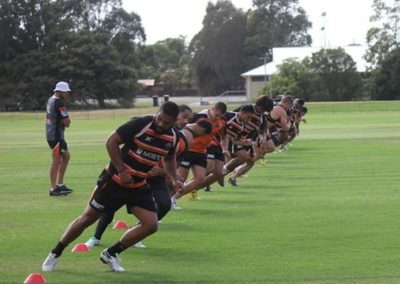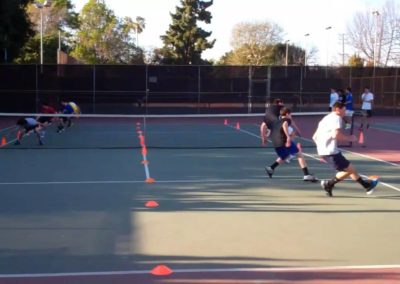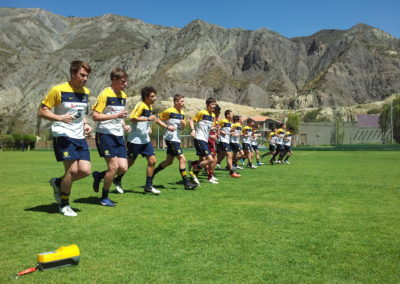The 30-15 Intermittent Fitness Test
The 30-15 IFT is an incremental, intermittent running test designed
to improve run-based high-intensity interval training (HIIT) prescription.
In comparison with continuous and/or linear tests, using the final speed reached at the end of the 30-15 test (VIFT) enables lower inter-individual differences in acute cardiorespiratory responses to HIIT – in other words, responses to HIIT are more similar between athletes using VIFT. This is because VIFT is a compound measure of maximal aerobic power, anaerobic speed reserve, inter-effort recovery and change of direction abilities – all components of performance for team and racquet sports (Buchheit 2005, 2008).
Le 30-15 Intermittent Fitness Test
Le 30-15 IFT est le premier test de terrain intermittent en course navette permettant de déterminer une vitesse maximale de référence pour l’entraînement intermittent, tout en tenant compte à la fois des qualités aérobies et anaérobies, des capacités de récupération et des qualités d’explosivité musculaire des membres inférieurs.
Le test est constitué de périodes de course d’une durée de 30 sec, entrecoupées de périodes de récupération marchée de 15 sec. La vitesse de course, initialement de 8 ou 10 km.h -1 , est ensuite incrémentée de 0.5 km.h -1 à chaque palier. En comparaison à la vitesse maximal aérobie par exemple, l’utilisation de la vitesse finale de course (VIFT) au 30-15 IFT permet d’homogénéiser les réponses métaboliques entre les joueurs lors d’exercices intermittents à haute intensité en course navette (Buchheit 2005, 2008).
El 30-15 Intermittent Fitness Test
El 30-15 IFT es una prueba de carrera qué consiste en correr ida y vuelta durante 30 segundos separados por períodos de recuperación pasiva de 15 segundos.
Los técnicos y entrenadores pueden usar el 30-15IFT qué lleva a una velocidad particular (VIFT) que tiene en cuenta varias cualidades solicitadas durante las carreras intermitentes de ida y vuelta, es decir, potencia explosiva de miembros inferiores, cualidades aeróbicas, y capacidad para recuperarse entre los turnos de ejercicios. El 30-15IFT se ha demostrado de ser exacto para individualizar las distancias cortas de la carrera intermitente en sujetos que presentan diferentes perfiles aeróbicos o anaeróbicos. Usando la VIFT como la velocidad de referencia para determinar las distancias de la carrera intermitente permite un nivel determinado de demanda cardiorespiratoria con bajas diferencias interindividuales para ser alcanzado que al usar la velocidad Aeróbica máxima determinada en forma continua (Buchheit 2005, 2008).
FOLLOW US
Watch the 2 videos
1) App presentation
2) introduction to the test with Martin Buchheit
4 versions to fit all purposes and fields of play
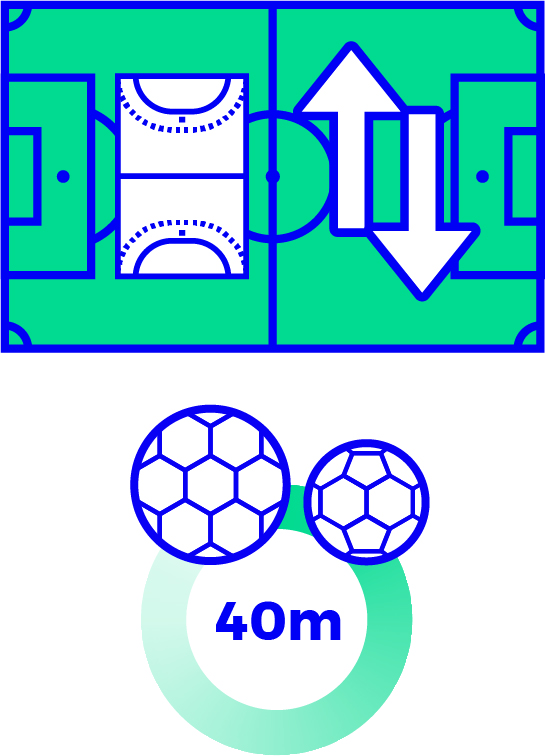
Original version, well adapted for handball (court length), soccer (width of the penalty area) and most of outdoor team sports
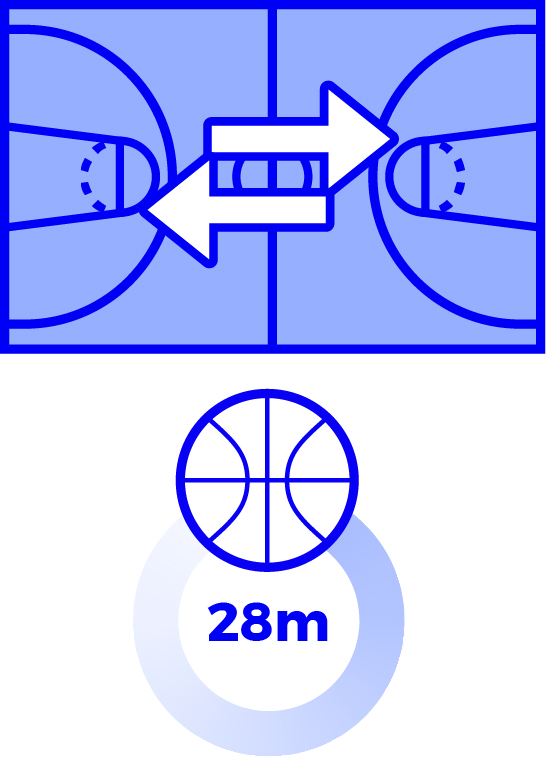
Modified vision for smaller courts such as basketball, netball and racquet sports

Straight-line version on a 400-m track without change of direction, better adapted for runners

Version specifically adapted for Ice Hockey
Protocol
Programming High Intensity interval Training
HIIT programming is a fine art. There are many ways to skin a cat to make the most of this very time efficient training tool. Please visit HIITscience.com and subscribe to the most advanced course on the topic
Test Performance
The speed of the last completed stage is called VIFT – use this speed as reference for prescribing HIIT
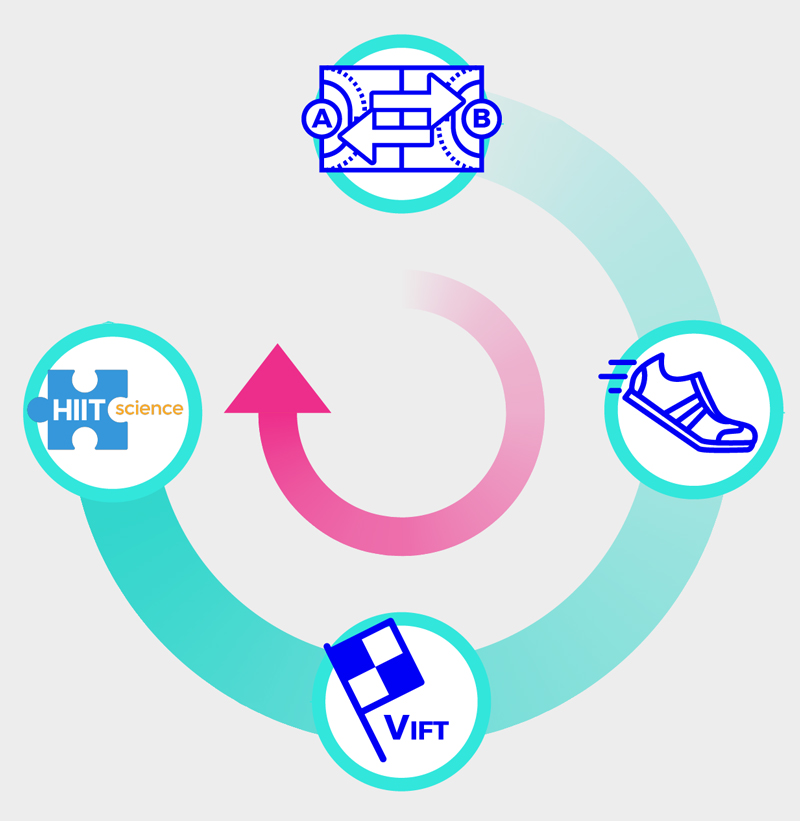
Test selection and setup
Choose the most appropriate 30-15 version and set up the testing area accordingly
Effort
Perform the test following the guidelines and give your best effort
Test Performance
The speed of the last completed stage is called VIFT – use this speed as reference for prescribing HIIT
Programming High Intensity interval Training
HIIT programming is a fine art. There are many ways to skin a cat to make the most of this very time efficient training tool. Please visit HIITscience.com and subscribe to the most advanced course on the topic
The App
Start test presentation (audio)
Start the audio file

Select language
Choose starting speed
Select your test protocol
Stop the audio file
Testimonials

Nick Poulos
HEAD OF PHYSICAL PERFORMANCE GWS GIANTS (AFL) – FORMER HEAD OF PERFORMANCE WITH RUGBY 7 AUSTRALIA & ADELAIDE CROWS (AFL)
“The 30-15 IFT is an important part of our testing battery and it has no equivalent when it comes to prescribing high-intensity intermittent training”

Jack Nayler
Head of Sport Science Celtic FC
“We use the 30-15IFT a few times a year to monitor our players’ fitness and prescribe intermittent training. It’s a great tool”

David Hamilton
DIRECTOR OF PERFORMANCE SCIENCE TAMPA BAY BUCCANEERS – FORMER OLYMPIC FIELD HOCKEY TEAM USA 2016 & TEAMGB 2004 & 2012
“The 30-15 IFT is a key component in our training approach both to evaluate players and prescribe our running conditioning program”

Franck Kuhn
Head of Strength & Conditioning French basket Team
“I’ve been using the 30-15IFT for more than 10 years and I just can’t think about a better way to asses our players”
About Martin Buchheit
I am a Strength & Conditioning coach that progressively developed into an applied sport scientist, with a main emphasis on football (soccer). My work has focused on intervention strategies and profiling assessments that may improve players’ physical and technical potential, using a scientific approach whenever possible.
Using my background in Strength & Conditioning (2 Msc), statistics (1 Msc) and a PhD in exercise physiology, I have developed different training ‘tools’ such as the 30-15 Intermittent Fitness Test to program high-intensity training and the 5-5 running test to monitor training status using heart rate variability.
I also have extensive experience with match analysis (GPS systems) and talent development and identification (i.e., elite soccer academies).

Video
Adelaide Crows (Australian Rules Football)
El Pozo (Fist Brazilian division futsal)
Borussia Dortmund (Bundesliga, Football)
SC Sélestat (Handball, 1st Div)
Brûleurs de Loup (Ice Hockey, 1st Div)

To learn more about
the benefits of the program
visit the blog
Report a bug
You found a bug ? Help us to improve the test
Newsletter
Suscribe to receive the newsletter









